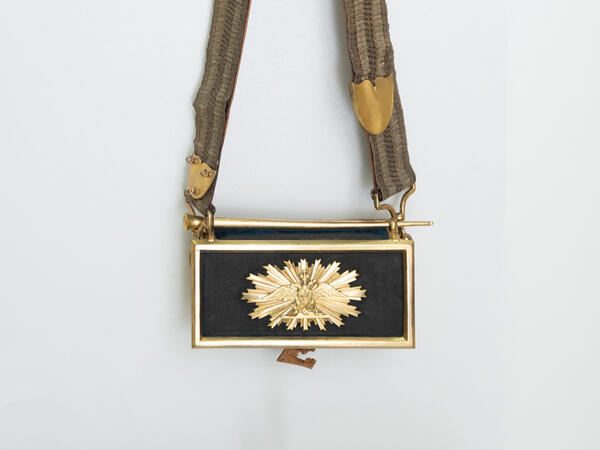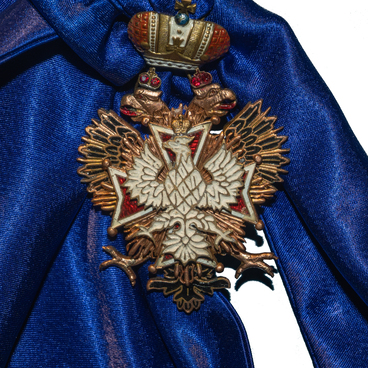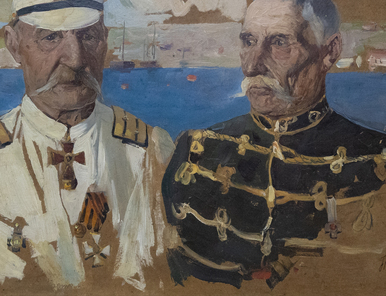Special cartridge boxes or bags were included in the equipment of the military. They were used to store ammunition supplies. The cartridge box presented in the exposition came from the funds of the Leningrad Military Medical Museum in 1959. It is a small rectangular wooden box with a hinged lid. The cartridge box is edged with metal. There is one compartment inside. The box was worn over on a shoulder belt with fastening loops.
The sides of the cartridge box are covered with dark blue velvet. The lid is decorated with a metal frame, in the center, there is a two-headed eagle against the background of diverging rays. The inner surface is trimmed with red leather, featuring the logo of E.D. Bitner Court Epaulet Factory. The lid is attached to the cartridge box with two hinges with a metal rod and closed with a leather tuck flap.
Cartridge boxes were introduced in the army in the 14th century. At first, gunpowder was stored in them, so the first such boxes were hermetically sealed and made of metal, which did not let moisture through and protected the gunpowder from getting wet. A little later, ammunition for firearms (for example, cartridges) or priming tubes began to be stored and carried in cartridge bags, which were sometimes made from rawhide.
In 1911–1915, cartridge boxes were used in the Russian imperial army, as well as in other countries such as France, Germany, England, Spain. In the Russian Empire, they could be found not only among the officers but also among the lower cavalry ranks.
There were certain rules on how to wear a cartridge box. The cavalrymen or artillerymen attached it to a special shoulder belt called a baldric. On the march, the cartridge box was supposed to be attached to the back. And in combat, before the firing started, the carbine or blunderbuss was detached from the baldric, and the cartridge box was moved to the chest.
Also, a sword, a cartridge bag, a cutter, and a knapsack were worn in the shoulder belt. It also provided fasteners for two copper and steel pickers on thin chains. The pickers were thin needles used to clean fire holes of a pistol, carbine, or blunderbuss.
The sides of the cartridge box are covered with dark blue velvet. The lid is decorated with a metal frame, in the center, there is a two-headed eagle against the background of diverging rays. The inner surface is trimmed with red leather, featuring the logo of E.D. Bitner Court Epaulet Factory. The lid is attached to the cartridge box with two hinges with a metal rod and closed with a leather tuck flap.
Cartridge boxes were introduced in the army in the 14th century. At first, gunpowder was stored in them, so the first such boxes were hermetically sealed and made of metal, which did not let moisture through and protected the gunpowder from getting wet. A little later, ammunition for firearms (for example, cartridges) or priming tubes began to be stored and carried in cartridge bags, which were sometimes made from rawhide.
In 1911–1915, cartridge boxes were used in the Russian imperial army, as well as in other countries such as France, Germany, England, Spain. In the Russian Empire, they could be found not only among the officers but also among the lower cavalry ranks.
There were certain rules on how to wear a cartridge box. The cavalrymen or artillerymen attached it to a special shoulder belt called a baldric. On the march, the cartridge box was supposed to be attached to the back. And in combat, before the firing started, the carbine or blunderbuss was detached from the baldric, and the cartridge box was moved to the chest.
Also, a sword, a cartridge bag, a cutter, and a knapsack were worn in the shoulder belt. It also provided fasteners for two copper and steel pickers on thin chains. The pickers were thin needles used to clean fire holes of a pistol, carbine, or blunderbuss.



